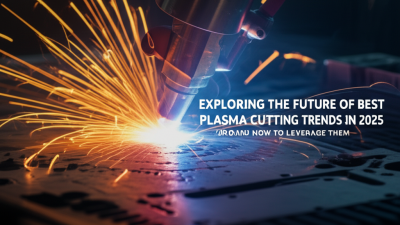Exploring the Future of Best Plasma Cutting Trends in 2025 and How to Leverage Them
As we step into 2025, the landscape of plasma cutting technology is poised for significant transformation, driven by innovations and increasing demand across various industries. According to a recent report by MarketsandMarkets, the plasma cutting market is expected to reach USD 4.03 billion by 2026, growing at a CAGR of 6.2% from 2021. This growth is fueled by advancements in automation and the rising need for precision cutting in sectors such as automotive, aerospace, and construction. As manufacturers strive for efficiency and quality, understanding the emerging trends in plasma cutting will be crucial. This blog will explore these trends and provide insights on how to capitalize on them, highlighting China's superior manufacturing capabilities at the forefront of this evolving market.

Trends Shaping the Plasma Cutting Industry in 2025: Key Innovations to Watch
The
plasma cutting industry is on the brink of transformation, fueled by several pivotal global megatrends that are set to redefine its landscape by 2025. Among these, advancements in
automation and
artificial intelligence (AI) stand out. As industries increasingly embrace smart technologies, the integration of AI with plasma cutting equipment is expected to optimize precision and efficiency.
Reports indicate that the global plasma technology market is projected to experience significant growth, with an expected increase in value, driven by its applications in
surface cleaning and coating processes.
Additionally, the expanding sheet metal fabrication services market, anticipated to grow to
USD 33.31 billion by 2034, highlights the increasing demand for efficient cutting solutions. The market, valued at
USD 21.35 billion in
2024, indicates a robust growth trajectory as businesses seek innovative methodologies to enhance productivity and
reduce waste. These innovations not only improve operational efficiency but also foster sustainability, aligning with global environmental goals as seen in the rising adoption of eco-friendly technologies within the industry.
The Role of Automation and AI in Enhancing Plasma Cutting Efficiency
As we approach 2025, the landscape of plasma cutting is set to undergo a dramatic transformation, largely driven by advancements in automation and artificial intelligence (AI). Automation is revolutionizing traditional fabrication processes by integrating high-tech machinery that can operate with minimal human intervention. This shift not only enhances productivity but also improves precision. Automated plasma cutting systems can execute intricate designs with consistent quality, significantly reducing the margin for error and waste material.
Alongside automation, AI is becoming a powerful ally in optimizing plasma cutting operations. By utilizing machine learning algorithms, AI can analyze real-time data from the cutting process to adjust parameters dynamically. This adaptability allows for optimal cutting speeds and reduces downtime caused by troubleshooting mechanical issues. Moreover, predictive analytics can foresee maintenance needs, ensuring systems are always running at peak performance. As manufacturers leverage these cutting-edge technologies, the efficiency and scalability of plasma cutting will redefine industry standards, opening new possibilities for innovation in metal fabrication.
Eco-Friendly Plasma Cutting Solutions: Sustainability in 2025
As we approach 2025, the plasma cutting industry is increasingly focusing on eco-friendly solutions that enhance sustainability without compromising efficiency. According to a report by Research and Markets, the global green technology and sustainability market is projected to reach $36.69 billion by 2025, with plasma cutting technology playing a pivotal role in this transformation. This trend is driven by a growing demand for processes that minimize waste and reduce energy consumption, prompting manufacturers to innovate with plasma cutting equipment that utilizes less energy while delivering high precision cuts.
In addition to energy efficiency, the adoption of alternative gases like hydrogen in plasma cutting processes is on the rise. A study by the International Energy Agency (IEA) indicates that switching to hydrogen could reduce carbon emissions by as much as 80% in industrial applications. This shift not only aligns with global sustainability goals but also offers companies the opportunity to differentiate themselves in a competitive market. Embracing these eco-friendly plasma cutting solutions not only meets regulatory pressures but also appeals to an increasingly environmentally-conscious consumer base in 2025.
Exploring Plasma Cutting Trends for Eco-Friendly Solutions in 2025
Leveraging Advanced Materials for Superior Plasma Cutting Results
As we look ahead to 2025, the plasma cutting industry is set to undergo substantial transformation, primarily driven by advancements in materials science. The trend towards utilizing advanced materials such as high-strength alloys and composite materials is gaining momentum. According to a recent report by MarketsandMarkets, the plasma cutting equipment market is expected to grow at a CAGR of 5.1%, reaching approximately $6 billion by 2025. This growth is fueled by the increasing demand for precision cutting and the integration of advanced materials in manufacturing processes.
To maximize the benefits of these cutting-edge materials, companies should consider several key strategies. First, invest in training personnel on the latest plasma cutting technologies and materials handling. Understanding the unique properties of advanced materials can significantly enhance cutting efficiency and quality. Second, implement regular maintenance and calibration of plasma cutting systems to account for different material thicknesses and compositions. This ensures optimal performance and longevity of the equipment.
Moreover, leveraging data analytics can provide insights into cutting parameters that yield the best results with advanced materials. By analyzing trends and performance metrics, businesses can optimize their processes, resulting in superior cutting accuracy and minimal waste. Investing in these practices will not only enhance operational efficiency but also position companies to thrive in the evolving landscape of plasma cutting.
Exploring the Future of Best Plasma Cutting Trends in 2025 and How to Leverage Them
| Trend | Description | Benefits | Advanced Materials |
|---|---|---|---|
| Faster Cutting Speeds | Implementation of optimized cutting technologies to improve efficiency. | Increased productivity and reduced operational costs. | High-performance alloys |
| Improved Energy Efficiency | Utilizing new technologies that consume less power. | Lower energy costs and environmental impact. | Advanced insulated materials |
| Automation and Robotics | Integration of automated systems for improved precision. | Enhances safety and reduces human error. | Engineered composites |
| Advanced Software Solutions | Utilization of sophisticated software for optimal cutting pathways. | Increased accuracy and material savings. | Data-driven materials |
| AI Integration | Leveraging artificial intelligence for process monitoring and optimization. | Enhanced control and decision-making capabilities. | Smart alloys |
Future Skills: Preparing the Workforce for Upcoming Plasma Cutting Technologies
As we head towards 2025, the plasma cutting industry is poised for significant advancements that will shape the skill sets required for its workforce. A recent report by MarketsandMarkets predicts that the global plasma cutting equipment market will grow from $3.6 billion in 2020 to $5.2 billion by 2025, showcasing a CAGR of 7.8%. This growth necessitates a workforce that is adept not only in traditional cutting skills but also in emerging technologies like automation and IoT integration.
To prepare for these transformative changes, training programs must evolve. Industry leaders are emphasizing the importance of incorporating digital skills into plasma cutting education. According to a study by the Fabricators & Manufacturers Association, over 70% of employers believe that digital literacy will be a critical competency for their employees in the near future. Collaborative training initiatives that combine hands-on experience with digital tools will be essential in equipping workers with the necessary skills to leverage advanced plasma cutting technologies effectively. Embracing these forward-thinking strategies will ensure that the workforce is ready to meet the demands of the evolving market landscape.

